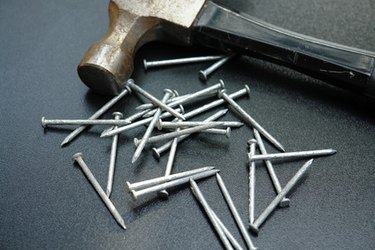Things You'll Need
Quarter-round molding
Miter box
Saw
Finish nails
Hammer
Nail set
Wood putty
Tape measure

Installing quarter-round molding is an inexpensive way to make a simple piece of baseboard look better or provide a neat finish to a flooring job. It can also be used by itself to create a clean look in a room. Quarter-round comes in different sizes. The most common size is 3/4-inch. When adding a piece of quarter-round to the top of a piece of 1-inch trim, use 3/4-inch quarter-round. This would match the top of the board perfectly. If you are placing quarter-round in front of the baseboard use any size you prefer or that will fill any gaps between the end of your new flooring and the wall.
Step 1
Make your first cut at a 45-degree angle using your miter box and saw, then make your measurement for the total length. If you are adding quarter-round molding to a four-cornered room, then all your cuts will be at a 45-degree angle with the angles running towards the center of the piece of molding.
Video of the Day
Step 2
Make butt joints where the baseboard meets the door trim. Every room has to have at least one door opening, so whenever you come to a door frame you can run the molding right up to the frame without cutting an extra 45-degree angle. Just make sure the butt joint is at a perfect 90 degrees. Don' trust the lumberyard; always cut the end of a piece of quarter-round before you place it.
Step 3
Wrap the molding around any abutments in the wall using a 45-degree miter joint. In this case, you will cut the angles in the exact opposite way that you did in Step 2. That means the angle begins at the curve in the wood and runs into the center of the piece of molding at a 45-degree angle.
Step 4
Splice together any pieces of molding with two 45-degree cuts that run in different directions. These cuts should fit together tightly and most likely will not be noticed if they are done right.
Step 5
Nail the molding to the floor at an angle using #6 or #8 bright-finish nails and set each nail with a small nail set.
Step 6
Fill each nail hole with wood putty. If necessary, you can fill the wood joints with putty, but a clean and careful cutting job should eliminate the need for this step.
Tip
In an old building, you may have to cope the joints of the quarter-round instead of using a miter joint. Quarter-round molding does not generally look attractive if used along the edge that is formed between the ceiling and the top of the wall. A better way to go is to leave the plaster finish or add a wide molding such as cove or crown molding.
Warning
Don’t use quarter-round molding to cover up cracks in the wall and ceiling or to hide a sloppy plastering job. Quarter-round is not the best choice to replace the baseboard if the room gets heavy use. A baseboard gives protection to a wall, and is necessary in any room that has a lot of foot traffic.
Video of the Day